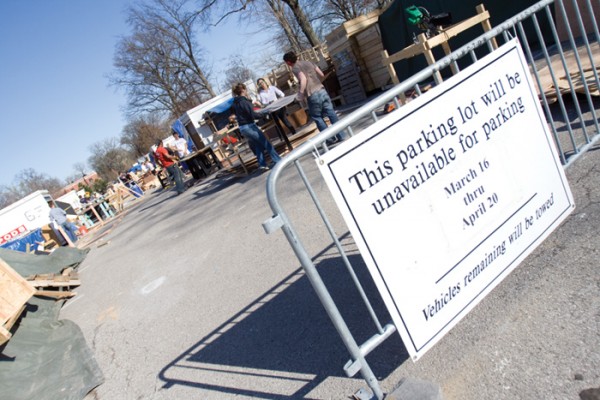Campus Events | Facilities and Construction | News
ThurtenE Honorary prepares for change in carnival location

Only a portion of the parking lot adjacent to Whitaker Hall will be used during the ThurtenE carnival this year due to the construction of the new engineering school building. (Evan Wiskup | Student Life)
ThurtenE Carnival, which will occur the weekend of April 18 and 19, has been moved this year to Brookings Drive, the grassy median in front of Brookings Hall. This is a break from previous years, when the carnival was held in the parking lot closest to Whitaker Hall.
The site has changed because of the reduction of parking lot space this year due to the construction of the Stephen F. and Camilla T. Brauer Hall, a new building for the Department of Energy, Environmental and Chemical Engineering.
The responsibility of coordinating the carnival lies with ThurtenE Honorary, which selects its cohort every year.
The change in location has posed problems that the honorary has not previously experienced.
The setup of the façades traditionally made by Greek organizations for the carnival will constitute one challenge of the new location, according to junior Andrew Weisberg, co-chair of public relations in the Honorary.
“[The setup of façades] in itself is a challenge, because it will not be on concrete but on grass,” Weisberg said.
Dean Henry Biggs, director of the Undergraduate Research Office and faculty adviser to ThurtenE Honorary, said that this setup on the grass will be one of the carnival’s greatest obstacles this year.
“The challenge is going to be that we’re going to be on the grass this year. That involves a whole new technology called event decking,” Biggs said.
By putting down an event deck—temporary flooring that will protect the grass—fraternities and sororities will be able to display their façades on Brookings Drive.
The University will be providing funding for the event deck.
“The University has been incredibly helpful—administration, parking and transportation, WUPD,” Weisberg said.
The school has also provided construction hats and floodlights to help ensure students’ safety when building the façades.
Most of the fraternities and all of the sororities on campus will build façades, and more than 50 student groups will have booths to sell food and host fun events during the carnival.
The roller coasters and other rides traditionally set up at the carnival will be located in the reduced parking lot closest to Whitaker Hall.
Before the final decision was reached on this arrangement, students and faculty discussed the possibility of moving ThurtenE to somewhere off campus. One possibility at the time was West Campus.
“Alumni development and undergraduate admissions were very interested in ThurtenE staying on this campus and not sending off to West Campus,” Biggs said.
All proceeds from this year’s carnival, excluding the money allocated toward operating expenses, will go to the Foundation for Children with Cancer.
The charity provides financial support to families with children undergoing cancer treatment.
“When a child is diagnosed with cancer, the average cost for that family is over $623,000,” Weisberg said.
Although hospitals may negotiate with families with insurance, families still need to focus on paying other expenses and can benefit greatly from financial support, according to Weisberg.
A carnival “larger than the student body”
The carnival has brought the Washington University student body and the St. Louis community together since its inception in 1904.
Weisberg, a member of the University’s chapter of Sigma Phi Epsilon fraternity, believes that the carnival, “unlike an event like W.I.L.D., where it is mostly for the Wash. U. community, not only brings the community together but also brings in the St. Louis community.”
“When I grew up in St. Louis, the one thing I remember of Washington University is that ThurtenE Carnival was great. It became one of the events that is larger than the student body,” Biggs said.
Despite some students’ criticism of the honorary’s tradition in keeping the books closed, “the most important goal is to increase the interaction between the Washington University and St. Louis community and to maintain the self-funded carnival,” Weisberg said.
Rather than focusing on the amount of donations as a measure of success, Weisberg said the honorary is most invested in making sure that people enjoy the façades and that students who have worked diligently on the carnival take pleasure in the fruits of their labor.
